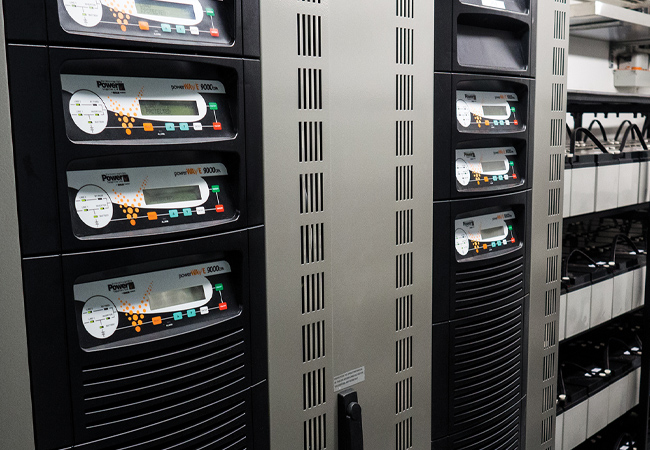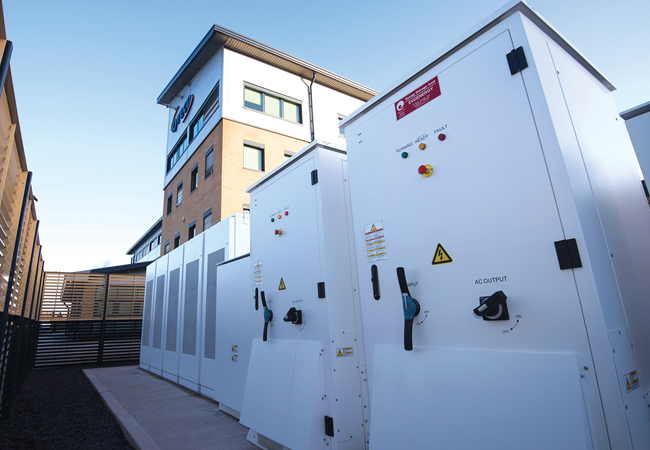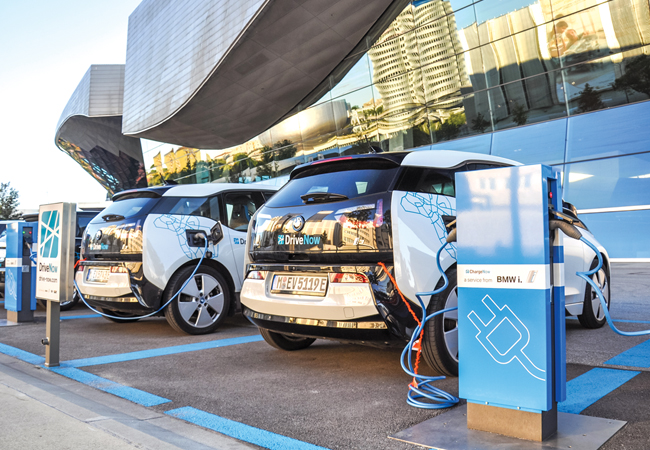
The Energy Superhub Oxford is an ambitious £41m project
On 5 October, a Kensa heat pump was installed in the first of 60 homes in Blackbird Leys, Oxford. The heat pumps are connected to a series of boreholes incorporating communal ground arrays. These are the first of 300 homes and commercial premises in and around Oxford that will feature ground source heating as part of the Energy Superhub Oxford (ESO).
The ESO is an ambitious £41m project, part-funded by the UK government’s Industrial Strategy Challenge Fund, which – in addition to low carbon heating – will demonstrate grid-balancing hybrid battery technology and large-scale rapid electric vehicle (EV) charging.
Smart software will manage the energy storage, EV charging and heat pumps to reduce strain on the grid and allow it to accommodate more renewables. The project is being led by Pivot Power, and when complete in 2022, it is predicted that it will eliminate 10,000 tonnes of CO2 emissions a year.
Heating is the single biggest contributor to UK emissions. The domestic heating element of the project will demonstrate how ground source heat pumps (GSHPs) can help minimise the carbon associated with heating homes and businesses.
In advance of the heat pumps’ installation, housing provider Stonewater has upgraded the homes’ fabric through the addition of cavity wall and loft insulation, coupled with the installation of double glazing.
Heat losses are generally between 4-5kW per home, so the majority of homes will be fitted with a 6kW heat pump. ‘Each home will have a heat pump connected to the shared outside infrastructure of pipes and boreholes,’ says Matthew Trewhella, managing director of Kensa Contracting.
The retrofit forms phase 1 of the project. Later phases will see up to 240 new-build homes fitted with GSHPs, and potentially various commercial properties too. Unusually, for the first phase the Oxford project has had to create six smaller communal arrays, one serving each cluster of homes, rather than use a single larger array. ‘Blackbird Leys is split into six smaller clusters because groups of houses are separated by roads, and so on,’ says Trewhella. Similarly, the area’s geology has necessitated a larger number of boreholes than usual for a scheme of this size. ‘Normally, we’d have gone with around 20 boreholes up to 220m deep, but because there is a layer of water about 100m below ground at high pressure, we’ve gone for 40 boreholes at about 96m depth,’ he says.
The ground array is simple; it comprises a piped water/glycol mix-filled circuit that operates at a temperature of between 0ºC and 12ºC to connect the homes to the boreholes. The homes are being fitted with dedicated heat pumps; these incorporate a circulating pump to pass the water/glycol from the ground loop through the heat pump at the appropriate flowrate.
‘When a householder turns on the heating, the heat pump will chill the water/glycol mix and the unit’s circulating pump will pass this to the boreholes, from where it naturally comes back warmer,’ says Trewhella.
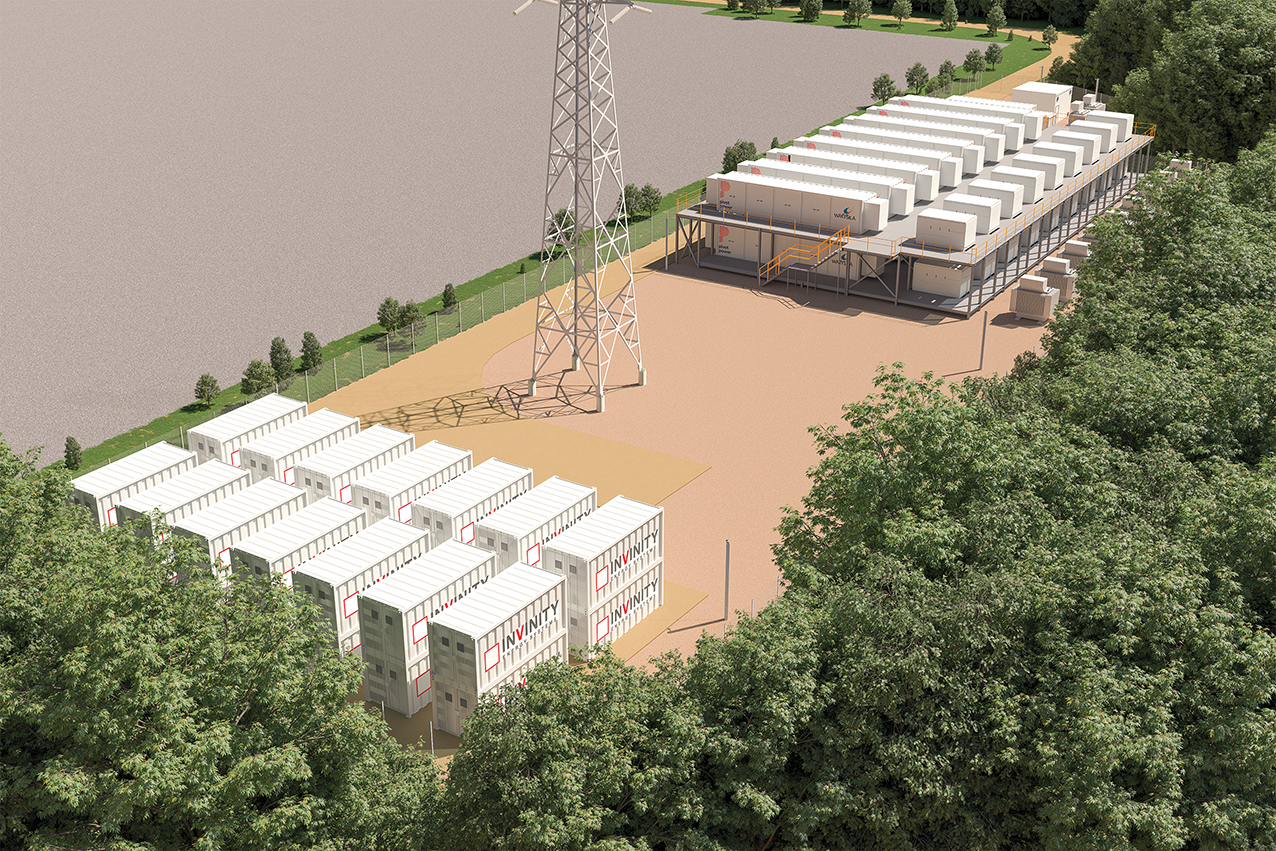
The ESO’s hybrid battery system is sited at the National Grid’s Cowley Substation
The heat pump absorbs heat and so reduces the temperature of the water/glycol mix by 5K before it returns to the boreholes, which enables it to supply the homes’ radiator circuit with water at 50oC, with a return temperature of 45oC. To heat the hot water cylinder, Trewhella says the ‘brakes are taken off’ to enable the heat pump off-temperature to rise to 65oC. ‘We limit the flow temperature of the heat pump to 45-50oC when it is running in heating mode. If we kept the heat pump at this flow temperature in domestic hot water mode, it would result in poor hot water performance and would not achieve sterilisation of the stored hot water. We, therefore, remove this limit when in hot water producing mode to allow the heat pump to heat the cylinder above 60oC,’ he says.
These will be the first of their kind in the UK, and the only major renewable heating solution capable of delivering domestic heating at a lower running cost than a traditional gas boiler
The homes’ heating systems are controlled using Switchee smart thermostats. These thermostats are capable of learning residents’ preferences – just using up and down temperature key presses. In previous projects (with gas boilers) Switchee found that around 30% of people are happy with the machine learning, but the rest opt for the thermostats to be programmed (which is normally done remotely while on the phone with a resident).
The thermostat’s inbuilt algorithm then learns how fast the temperature increases in the property when the heating is turned on, and how fast it drops when the heating is turned off, in order to optimise the heating control. Uniquely, this optimum start control will be linked to the cloud-based heat optimisation platform.
One of the project’s objectives is to show that a low carbon heating system can also be the cheapest to run. ‘We’re up against what physics will allow on the efficiency of the heat pump; some gains are expected, but they will be incremental compared with the potential for reducing electricity prices, so the next thing is to put in place measures to reduce the price of the electricity used,’ says Trewhella. To do that, tenants are being recommended to switch to a ‘dynamic’ electricity tariff with electricity priced in 30-minute intervals throughout the day. Dynamic electricity tariffs offer consumers cheap energy when electricity demand is low and renewable energy is plentiful, and higher prices when demand peaks.
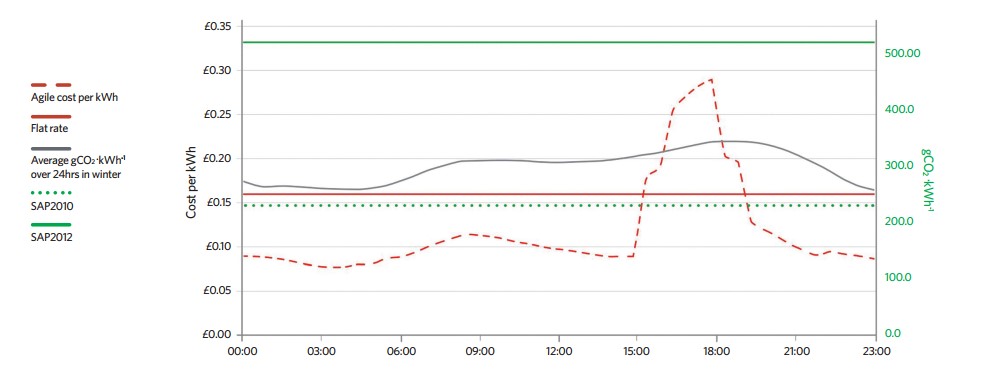
Figure 1: This graph from Kensa shows cost of electricity on different tariffs over a 24-hour period. The solid red line is the standard tariff, which is around 16p per kWh. The broken red line represents the six-monthly averaged dynamic electricity price, which shows that the dynamic tariff is cheaper than the standard tariff at most times of the day or night (except between around 15:30 to 19:00). The grey line is the carbon intensity of the grid
The dynamic pricing, available a day in advance, is used by the heat optimisation platform, which automates the load shifting; it takes occupancy information from the smart thermostat and combines it with the half-hourly electricity tariff information to optimise turn-on and turn-off times for the heat pump. This enables the occupants to take advantage of the dynamic tariff without having to change their behaviour.
The Kensa platform uses the heat-up and cool-down times determined by the Switchee algorithm as a proxy for the amount of thermal storage offered by each property. Working within the occupant’s comfort parameters, the heat optimisation platform will use the fabric of the property to store heat energy ahead of peak electricity times to raise the temperature of the building when electricity is cheap, so the GSHP can turn off when electricity is at its most expensive.
‘If people want to be 21oC at 5pm, the regular algorithm would call for the heating to come on at 4pm, say, so that by 5pm the temperature is up to 21oC,’ says Trewhella. ‘However, we know electricity will be cheaper between 1pm and 4pm, so we might heat the property to be warmer than 21oC earlier – that might be 22oC or 23oC at 5pm – and the temperature could coast down over time.’
The plan is to run the heat pumps under normal control up to Christmas so that the system can learn the homes’ response characteristics before commencing active load shifting (see Figure 1).
By avoiding the high-cost period, occupants will also reduce the overall carbon intensity of the electricity they consume
‘Our original thought when we were first involved with this demonstrator was that we would run the heat pump when electricity was cheap. However, it turns out from our modelling that we expect not to run the heat pump when electricity is expensive,’ says Trewhella.
By load shifting Kensa expects to reduce the cost of heating by up to 25%, compared with running the heat pump on a standard electricity tariff. By avoiding the high-cost period, occupants will also reduce the overall carbon intensity of the electricity they consume and will also help ease the strain on the grid. ‘Optimising the system on the price of electricity gives the highest consumer acceptance, but we could chose to optimise on any of these variables; whichever you select, you will benefit the other two,’ says Trewhella.
Of the properties in the first phase, 56 are currently heated using electric night storage, while four are heated using gas. As part of the project, the University of Oxford is surveying the residents and obtaining historical bill data to set a baseline for how much they currently pay.
Trewhella says it’s a difficult assessment because consumption will vary with the weather and because, in Kensa’s experience of social housing schemes, when people do have cheaper heat, they tend to keep homes a little warmer. Nevertheless, it is estimated that replacing the night storage heaters with a shared ground loop array and individual GSHPs will produce lifetime bill savings of £19,225 per property (based on a recent ECO3 submission).
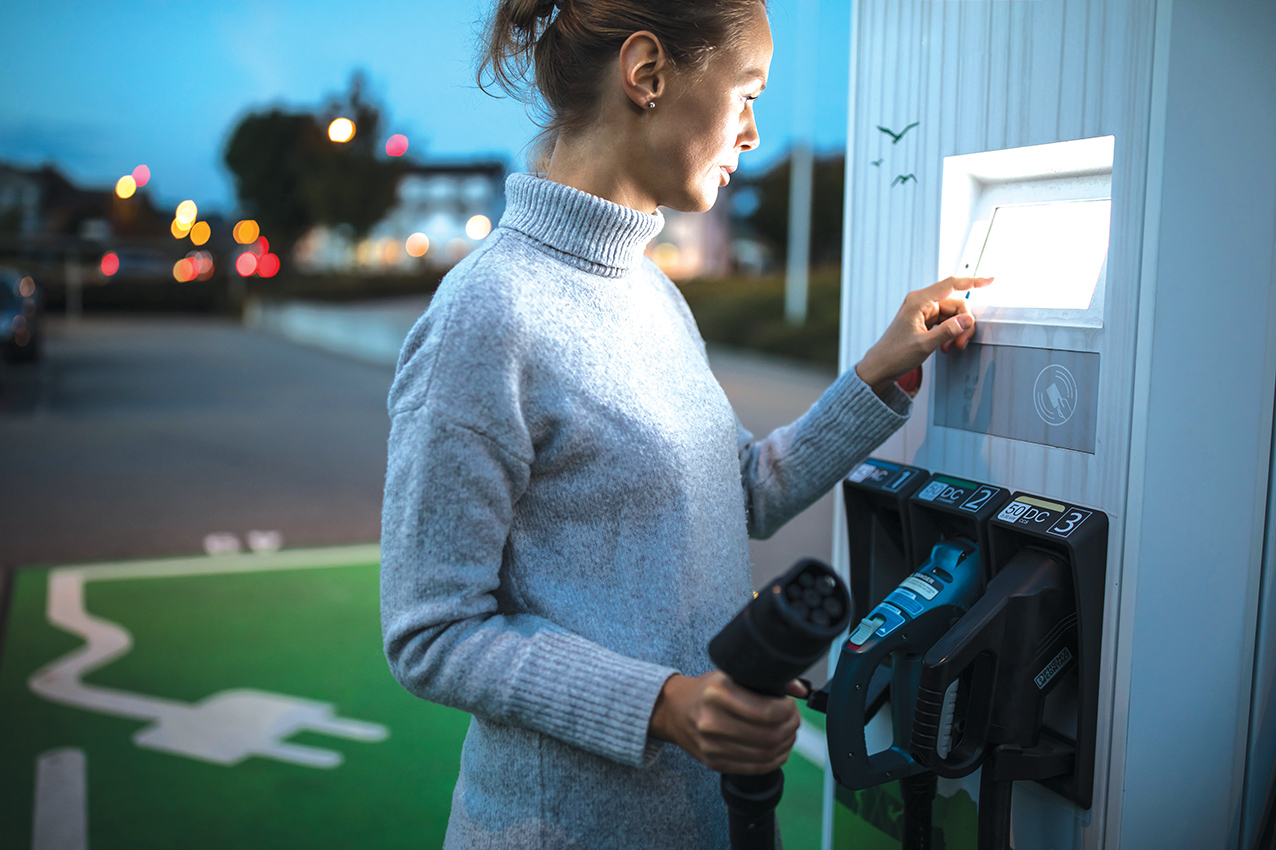
Electric vehicle charging infrastructure will be an integral part of the ESO project
Lifetime, as defined by Energy Company Obligation (ECO) – the government’s scheme to reduce carbon emissions and tackle fuel poverty – is 40 years. In reality, the boreholes have an expected lifetime of 120 years and the heat pumps 20-25 years, so 40 years is an average’ of the two main components to represent a ‘system lifetime’.
When combined with a smart thermostat and the heat optimisation platform, the predicted lifetime bill savings per property are £31,575 for the night store properties. For the 300 properties in the ESO with GSHPs, total lifetime bill savings are expected to be £2-3m, as the electric heat pumps displace gas heating.
‘These heating systems will be the first of their kind in the UK, and the only major renewable heating solution capable of delivering domestic heating at a lower running cost than a traditional gas boiler, with no local emissions and the lowest carbon intensity of any heating,’ says Trewhella.
‘We’ve done a lot of modelling, and there is no question there will be cost savings on the homes with electric night storage heating – even without load shifting they can expect to halve their bills. For the gas-heated homes it will be tighter, but we’re still confident there will be cost savings,’ he says.

Boreholes being drilled in Blackbird Leys
Stonewater will also be able to claim non-domestic Renewable Heat Incentive (RHI) payments for the project: ‘Because you are sharing the heat source, which ultimately is the ground, the system is classed as a district heating system, which is eligible for non-domestic RHI, providing a 20-year income for the property owner,’ he adds.
The GSHP is only one part of the ESO; the scheme also includes the UK’s first transmission-connected battery to enable load-shifting for the overnight charging of the council’s fleet of EVs and the opportunity to provide balancing services to the National Grid – and to trade on the Day Ahead and Intraday energy markets.
Currently, the GSHP element of the ESO is set up to operate as an independent entity. However, Trewhella says there are synergies to be had from linking the GSHP to the battery in the future. ‘There is no doubt that balancing the electricity supply grid generally with batteries while at the same time turning vehicle charging on and off and turning heat pumps on and off and treating the whole thing as a collective will have huge benefits,’ he says.
What is a vanadium flow machine?
Invinity Energy Systems’ energy storage machines employ vanadium ions in different oxidation states to store chemical potential energy.
A conventional battery stores chemical energy within an electrolyte solution, while a vanadium fl ow machine contains two different electrolyte solutions, each in a separate tank.
When the vanadium flow machine is charged, one electrolyte is positively charged and one is negatively charged. In order for the battery to provide power, the electrolytes flow through a fuel cell stack on opposite sides of a proton exchange membrane. Their opposite charges create a gradient that powers an external current.
There are two main characteristics unique to vanadium fl ow machines that make them suited to utility-scale storage. First, unlike conventional batteries, power output is independent from energy storage capacity.
Output depends on the size of the membrane stack (the engine), while the energy storage capacity depends on the size of the electrolyte tanks(the fuel). Neither constrains the other, although the ratio of storage to power determines how long the batteries can run without recharging. Power can flow undiminished as long as there is fresh electrolyte to circulate through the stack.
The ESO’s battery is sited at the National Grid’s Cowley Substation. It is a hybrid battery comprising a 50MW Wartsila lithium-ion battery and a 2MW Invinity Energy Systems vanadium flow battery, which does not degrade with use (see ‘What is a vanadium flow machine?’ panel, above). This combination of battery technologies has been designed to provide synergies to support the National Grid’s Fast Frequency Response (FFR) tenders, so the battery control system will attempt to use the full capacity of the vanadium flow battery first to reduce degradation in the lithium-ion unit. The lithium-ion batteries can then be saved for high value cycles, for which the vanadium batteries are less suited – for example FFR – where the income levels justify the degradation cost.
The final component of the ESO is an EV charging network, which is connected to the National Grid’s high voltage transmission network, bringing an unprecedented amount of power to Oxford for rapid vehicle charging and enabling the charging of big EV fleets, including that of Oxford City Council. This will provide up to 25MW for EV charging – enough power for well over 100 ultra-rapid chargers. The project will also explore the value to be gained by ‘smart’ charging, using variable time-of-day tariffs to pick the cheapest times to charge.
Just as the heat pumps will use smart controls to optimise comfort and cost for residents, an optimisation and trading engine will underpin both battery activity and EV charging so they automatically use cheaper, cleaner electricity when available, and to help balance the grid as the supply fluctuates under the influence of renewables
Work on the ESO was due to run until March 2022 but, as a result of Covid-19, the completion date has now been extended until June 2022, by which time 300 GSHPs will have been installed.

